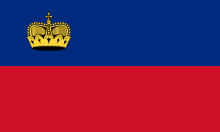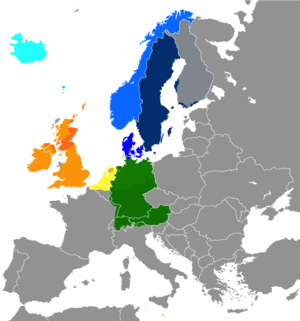Germanic-speaking Europe
Germanic-speaking Europe refers to the area of Europe that today uses a Germanic language.
Speakers
Over 200 million Europeans (some 30%) speak a Germanic language natively.
- West Germanic (~180 million)
- German-speaking Europe (90 million)
- Germans (78 million)
- Austrians (7 million)
- Swiss (4.6 million)
- South Tyroleans (0.3 million)
- Belgians (0.1 million)
- Luxembourgish
- Luxembourgers (0.3 million)
- Dutch (22 million)
- Dutch people (16 million)
- Flemish people (6 million)
- English-speaking Europe (58 million)
- Frisians (0.5 million)
- German-speaking Europe (90 million)
- North Germanic (22 million)
- Swedes (9.5 million)
- Danes (6 million)
- Norwegians (4.7 million)
- Icelanders (0.3 million)
- Faroese (0.07 million)
- Ålanders (0.03 million)
- Finland-Swedes (0.3 million)
Countries
Independent European countries whose population are predominantly native speakers of a Germanic language:
 Austria
Austria.svg.png) Belgium (partially)
Belgium (partially) Denmark
Denmark Germany
Germany United Kingdom
United Kingdom Netherlands
Netherlands Norway
Norway Sweden
Sweden Iceland
Iceland Ireland
Ireland Liechtenstein
Liechtenstein Luxembourg (partially)
Luxembourg (partially) Switzerland (partially)
Switzerland (partially)
| Countries without officially recognised minority | Countries with an officially recognised non-Germanic minority | Countries with a Germanic minority |
|---|---|---|
|
|
West Germanic
German
German is the sole official language in Germany, Austria, and Liechtenstein, and is a co-official language in Switzerland, Belgium, Luxembourg, and the European Union. Several other countries, including Denmark, Hungary, Italy, and Poland, have German as a national minority language.
English
English is a West Germanic language originating in England, and the first language for most people in Australia, Canada, the Commonwealth Caribbean, Ireland, New Zealand, the United Kingdom and the United States (also commonly known as the Anglosphere).
One of the consequences of the French influence due to the Norman Conquest in the Middle Ages is that the vocabulary of the English language contains a massive number of non-Germanic words, i.e., Latin-derived words that entered the lexicon after the invasion.
English vocabulary is, to an extent divided between Germanic words (mostly Old English) and "Latinate" words (Latin-derived, directly from Norman French or other Romance languages). For instance, pairs of words such as ask and question (the first verb being Germanic and the second Latinate) show the division between Germanic and Latinate lexemes that compose Modern English vocabulary. The structure of the English language, however, has remained unequivocally Germanic.
Dutch
In Europe, Dutch is spoken in the Netherlands (~96%) and Flanders, the northern part of Belgium (~59%). In French Flanders, in northern France, some of the older generation still speaks the local Dutch dialect. Outside Europe, Dutch is official in Suriname, Aruba and the Netherlands Antilles. In Indonesia, Dutch is spoken by the Indo people. Afrikaans, the third most spoken language in South Africa, in terms of native speakers (~13.3%), and the most widely understood in Namibia, evolved from Dutch and was standardised in the early 20th century. Both languages are still largely mutually intelligible.
Frisian
The Frisian languages are a closely related group of Germanic languages, spoken by about half a million members of Frisian ethnic groups, who live on the southern fringes of the North Sea in the Netherlands and Germany. They are the continental Germanic languages most closely related to English.
North Germanic
Approximately 20 million people in the Nordic countries have a North Germanic languages as their mother tongue,[1] including a significant Swedish minority in Finland.
See also
References
- ↑ Holmberg, Anders and Christer Platzack (2005). "The Scandinavian languages". In The Comparative Syntax Handbook, eds Guglielmo Cinque and Richard S. Kayne. Oxford and New York: Oxford University Press. Excerpt at Durham University.
